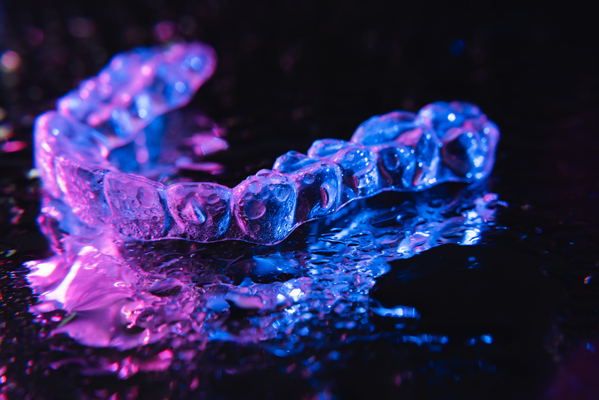Invisalign vs. Lingual Braces

Many have heard of Invisalign®, a type of clear aligner treatment. However, fewer are familiar with lingual braces and how they work. This review offers an in-depth look at Invisalign vs. lingual braces with insights into the pros and cons of each option and when one might be preferable to another.
Invisalign® and lingual braces for straighter teeth
Invisalign and lingual braces both provide a more discreet treatment option for patients than traditional braces, although there are some notable differences. By learning more about Invisalign and lingual braces, you will be able to make a more educated decision and choose which is the more preferable solution for you.
How does Invisalign® work?
Invisalign is a popular form of clear aligners treatment. It involves the use of transparent trays that are made of a strong plastic material. Each transparent tray is customized for an ideal fit, and the Invisalign aligners gradually pull and push teeth into the ideal alignment. The trays are also removable, which allows for fewer dietary restrictions and other notable benefits (see below). The treatment process involves a new set of aligners every week or two, and treatment takes six months to two years to complete.
How do lingual braces work?
Lingual braces are fixed orthodontic appliances that attach to the inside of teeth, rather than on the visible surface. They are far more discreet than traditional braces, which is why many prefer them. They may be the best solution for moderate to severe alignment and spacing concerns, particularly when Invisalign is not a viable treatment option. They work in essentially the same way as traditional braces and gently pull and push teeth until the patient and dental professional are satisfied with the overall teeth and jaw alignment.
The pros and cons of Invisalign®
There are many benefits of Invisalign that other treatment options such as lingual braces and traditional braces do not provide. Among the most notable benefits include:
- More discreet treatment
- Removable aligner trays
- Fewer food restrictions
- More comfortable treatment
- Easier to care for teeth
For many patients, the pros outweigh the cons of Invisalign. However, Invisalign is less able to treat severe alignment concerns. Also, patients (or parents of patients) who are worried about losing or not properly wearing the removable aligners may prefer braces treatment.
The pros and cons of lingual braces
Lingual braces are also discreet, which is a huge advantage over traditional braces. They also are often more effective than Invisalign at correcting severe misalignments. However, lingual braces may take some time to get used to as they can interfere with the movement of the tongue since they are attached to the inside parts of the teeth.
Contact us to discuss orthodontic treatment options
You can learn more about Invisalign and lingual braces by contacting our office today and speaking with one of our experienced dental professionals. We pride ourselves in offering friendly and professional service, and we can help you feel comfortable and in control through each step of the treatment process.
Are you considering Invisalign in the Tulare area? Get more information at https://brianbelldds.com.
Check out what others are saying about our dental services on Yelp: Invisalign in Tulare, CA.
Related Posts
Taking children to a kid friendly dentist is a great idea, especially if there is a noticeable dental issue, such as white spots. White spots should never be ignored, regardless of the patient's age. However, children need to visit a kid friendly dentist because their teeth are still developing. Learn more about taking a child…
A general dentist is someone who helps individuals maintain a healthy oral cavity, and that includes performing root canal therapy as needed. Root canals are a procedure that often strikes anxiety in individuals because it was once said to be painful; however, that is actually far from true! Modern-day dentistry has allowed for quite the…
A cosmetic dentist plays a crucial role in enhancing both the function and appearance of a patient's teeth. Some treatments are more effective for a smile's appearance than its function. Understanding the difference between corrective and aesthetic dentistry is essential for anyone considering dental improvements.Corrective dentistry addresses structural problems and functional issues within the oral…
Dental crowns are a reliable and durable solution for restoring the appearance and function of damaged teeth. While dental crowns are designed to last years, proper care and maintenance are essential for extending their lifespan. Following practical steps and working closely with your dentist can protect your investment and enjoy a confident smile for years.Maintaining…
